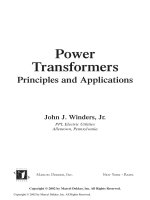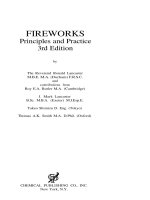distillation principles and processes
Bạn đang xem bản rút gọn của tài liệu. Xem và tải ngay bản đầy đủ của tài liệu tại đây (14.53 MB, 536 trang )
CORNELL
UNIVERSITY
LIBRARY
ENGINEERING
TP
156
Y76
me
"
Universi,y
Library
Distillation
principles
and
processes
3 1924
003
958
216Cornell
University
Library
The original of this book is in
the Cornell University Library.
There are no known copyright restrictions in
the United
States
on the
use
of the text.
/>
AND PROCESSES
MACMILLAN AND CO., Limited
LONDON
•
BOMBAY CALCUTTA
•
MADRAS
MELBOURNE
THE MACMILLAN
COMPANY
NEW
YORK
BOSTON CHICAGO
DALLAS
•
SAN FRANCISCO
THE
MACMILLAN
CO.
OF CANADA, Ltd.
TORONTO
DISTILLATION
PRINCIPLES
AND
PROCESSES
BY
SYDNEY
YOUNG
M.A.,
D.Sc,
F.R.S.
PROFESSOR
OF CHEMISTRY
IN DUBLIN
UNIVERSITY
WITH
THE COLLABORATION
OF
Lieut Col. E.
BRIGGS, D.S.O.,
B.Sc.
T. HOWARD
BUTLER, Ph.D.,
M.Sc,
F.I.C.
THOS.
H. DURRANS,
M.Sc, F.I.C.
The Hon.
F. R. HENLEY,
M.A., F.I.C.
JOSEPH
REILLY,
M.A., D.Sc,
F.R.C.Sc.L,
F.I.C.
WITH TWO HUNDRED AND TEN ILLUSTRATIONS
103
MACMILLAN
AND CO.,
LIMITED
ST. MARTIN'S
STREET,
LONDON
1922
COPYRIGHT
PRINTED
IN
GREAT BRITAIN
PBEFACE
The volume on
"
Fractional Distillation
"
was written in the hope
that
it would be of assistance to chemists in
overcoming the difficulties
so frequently met with in the laboratory,
not
only in the actual carrying
out
of the fractional distillation of a complex mixture but
also in the
interpretation of
the results
obtained.
The last copy was sold shortly after the declaration of
war, and the
question then arose whether a revised second edition of
the book in
its original form should be published.
It
was
thought, however, by
the
Publishers that it would be wiser to extend the scope
of
the
work
so as to include distillation on the large
scale as carried out in the
manufacture of
important products.
That this change in the character
of the book was
really advisable
became
more and more evident as the war
increased
in
intensity and
magnitude, because of the immense
importance of such materials
as
acetone, toluene,
petrol, glycerine, and so
on,
the
production of which
involved processes
of distillation on an enormous scale,
and for some
of
which new sources or methods
of formation had to be sought and
investigated.
It was
obvious that the
larger book could only
be
of real value
if
the
sections on
manufacturing processes were written by chemists
thoroughly
conversant with the various
subjects dealt with, and it
was
eventually
decided that I should edit the book
if
I
could
secure the
co-operation
of experts in the different branches
of manufacture.
In these
preliminary
negotiations
I
received most valuable assist-
ance
from my
friends, Professor P. E. Francis, D.Sc,
Ph.D., and
Professor W.
E. Adeney, D.Sc, and my sincere
thanks are especially
due
to
Professor Francis for
the great
interest he has
taken
in the
production of the
book.
Unfortunately the heavy pressure of work entailed on
all chemists
by
the
war caused serious delay in commencing the book,
and progress
has
necessarily been slow.
The new work
consists
of seven
sections, the first of which is
vi
DISTILLATION
PRINCIPLES AND PROCESSES
practically
a revision of
"
Fractional Distillation."
In this
section
full reference
is made to the valuable researches of Wade,
Merriman,
and Pinnemore,
of Rosanofi
and
his co-workers, and of
Lecat
;
there
is
also an additional chapter on Sublimation.
The remaining
sections,
dealing
with manufacturing processes,
are
as follows :
2.
Distillation of Acetone and »-Butyl Alcohol on the
Manufacturing
Scale, by Joseph
Reilly, M.A., D.Sc, F.R.C.Sc.L, F.I.C.,
Chemist-in-
charge at the
Royal Naval
Factory, Holton Heath, Dorset, and the
Hon.
F.
R.
Henley, M.A.,
F.I.C.
3. Distillation
of Alcohol on the
Manufacturing
Scale, by
the
Hon.
F. R.
Henley and Dr.
Reilly.
4.
Fractional Distillation as applied in the
Petroleum Industry, by
James
Kewley, M.A., F.I.C, Member
of Council of
the
Institution
of
Petroleum
Technologists.
5.
Fractional Distillation in the Coal Tar Industry, by T.
Howard
Butler, Ph.D.,
M.Sc, F.I.C,
Managing Director of William Butler &
Co. (Bristol), Ltd.,
Tar, Rosin, and Petroleum Distillers.
6.
The Distillation
of Glycerine,
by
Lieut Col. E. Briggs, D.S.O.,
B.Sc,
Technical Director, Broad Plain Soap Works,
Bristol.
7. The
Distillation of Essential
Oils, by
Thos. H. Durrans, M.Sc.
(London), F.I.C,
of Messrs. A. Boake Roberts & Co., Ltd., London.
S.
Y.
Dublin, August 1921.
PREFACE
TO "FRACTIONAL
DISTILLATION"
During the past
eighteen years I have been engaged in
investigations
which necessitated
the
preparation
of chemical materials in the
purest
possible state,
and as the great majority of these substances
were
liquids,
the process of fractional
distillation had, in most
cases, to be
resorted
to for their purification.
The
difficulties I met with in some of the separations
led
me to
make
a
careful investigation
of the whole subject, and
I
was thus
enabled to
devise
some new methods and
forms
of
apparatus, which have
been
described from time to time in various
scientific journals.
It
is in the
hope that
the
solution of the difficulties which so
often
occur in carrying out a fractional
distillation may be rendered
easier,
and that the value and economy of highly efficient still-heads in labora-
tory work may come to
be more widely recognised than is
generally
the case at present, that this book has
been
written.
My sincere thanks are due to Professor J. Campbell Brown for the
loan of valuable ancient works by Libavius and
Ulstadius,
from which
Figures 2 and 34
l
have been taken
;
to my colleague, Dr. F. E. Francis,
for reading the
proofs, and for much
valuable assistance in
compiling
the
index
;
and to Professor R. A. Gregory and Mr.
A. T.
Simmons,
B.Sc, for
many useful suggestions regarding
the arrangement of the
MS.
and for the
perusal of the proofs.
In the
description and illustration of the stills
employed in commerce
I have
derived
much assistance from
articles in Thorpe's
"
Dictionary
of
Applied
Chemistry
"
and Payen's
"
Precis de chimie industrielle."
I
have
made much use of
the experimental
data of Brown, Kono-
walofi,
Lehfeldt, Zawidski, and other
observers,
and have, as far as
possible,
made due
acknowledgment,
but in some of
the tables this has
not
been practicable.
Several fractional
distillations
and
numerous experiments have
been
carried out while the
book was
being written
and the results have
in
many
cases
not been published
elsewhere.
S.
Y.
Bristol, August
1903.
1
Now Fig. 41.
DISTILLATION
PEINCTPLES AND PEOCESSES
CHAPTER
I
PAGE
Introduction
—
Apparatus required . 3
CHAPTER
II
The Boiling Point of a Pure Liquid
20
CHAPTER
III
Vapour
Pressures of Mixed Liquids . . 27
CHAPTER
IV
Boilin'g
Points of Mixed Liquids
40
CHAPTER
V
Composition of Liquid and Vapour Phases
;
Experimental Deter-
minations
.
. .
62
CHAPTER
VI
Composition
of Liquid and
Vapour Phases, considered Theoretically 77
CHAPTER
VII
Directions
for
carrying out
a Fractional
Distillation . 98
CHAPTER VIII
Theoretical
Relations
between
the Weight
and Composition of
Distillate
.
.
.
117
CHAPTER
IX
Relation between the
Boiling Points of Residue and Distillate. 123
ix
DISTILLATION
PRINCIPLES
AND
PROCESSES
CHAPTER
X
Modifications
of
the Still-head
126
CHAPTER
XI
Modifications
of the
Still-head {continued);
Bubbling
Still- heads 140
CHAPTER XII
Modifications
of the
Still-head
(continued); "Regulated" or
"Constant Temperature"
Still-heads
.
.
.
148
CHAPTER
XIII
Continuous
Distillation
.
.
. 154
CHAPTER
XIV
Fractional
Distillation with
an improved Still-head
.
158
CHAPTER
XV
Distillation
on the
Manufacturing Scale
.
.
. 163
CHAPTER XVI
Fractional Distillation as a Method of Quantitative
Analysis . 170
CHAPTER XVII
Methods
by which
the Composition of Mixtures of Constant Boil-
ing Point may be determined
. . .
184
CHAPTER XVIII
Indirect Method of separating the' Components
of a Mixture
of
Constant Boiling Point
.
.
.190
CHAPTER XIX
General Rf.marks.
—
Purposes
for which Fractional Distillation is
required.
Interpretation of
Experimental Results.
Choice
of Still-head, Number of
Fractions,
Etc.
. 196
CONTENTS
xi
CHAPTER XX
PAGR
Sublimation . .
222
APPENDIX
.
229
DISTILLATION OF
ACETONE
AND
ra-BUTYL
ALCOHOL
ON
THE MANUFACTURING SCALE
CHAPTER
XXI
Acetone . . .
. 233
CHAPTER XXII
Production of Acetone
and w-Butyl
Alcohol, by
the Fermentation
Process 236
CHAPTER
XXIII
Production of
Acetone
by means other than Fermentation . 247
CHAPTER XXIV
Acetone
Recovery
254
CHAPTER XXV
The
Testing of Acetone
and ?i-Butyl Alcohol.
. 257
DISTILLATION OF
ALCOHOL ON THE MANUFACTURING
SCALE
CHAPTER
XXVI
Distillation
of
Mixtures
of Ethyl Alcohol and Water (Theo-
retical)
267
CHAPTER XXVII
Distillation of Mixtures of "Water and Ethyl Alcohol, with
the
other Volatile Products of Fermentation
281
CHAPTER
XXVIII
Stills and Distillation in Practice
.
.
297
DISTILLATION PRINCIPLES
AND
PROCESSES
FRACTIONAL DISTILLATION AS APPLIED IN THE
PETROLEUM INDUSTRY
CHAPTER
XXIX
PAGE
Introduction .
"
. 321
CHAPTER XXX
Periodic
Distillation
. .
.
324
CHAPTER
XXXI
Continuous
Distillation under Atmospheric Pressure
334
CHAPTER
XXXII
Continuous
Distillation
under Atmospheric Pressuke (continued) .
343
CHAPTER
XXXIII
Distillation under
Reduced Pressure . .
352
CHAPTER
XXXIV
Various
Distillation
Methods .
.
. 356
FRACTIONAL
DISTILLATION IN THE COAL TAR
INDUSTRY
CHAPTER
XXXV
Introduction
.
361
CHAPTER XXXVI
Distillation of
Tar
.
367
CHAPTER
XXXVII
Further
Distillation
and Rectification
of Primary
Fractions
of
Tar
384
CONTENTS
CHAPTER
XXXVIII
PAGE
Fractional
Separation of the
Naphthas
and
Light Oils
.
. 392
THE DISTILLATION OF
GLYCERINE
CHAPTER
XXXIX
The Distillation of Glycerine
.
.
. . 425
THE DISTILLATION OF
ESSENTIAL OILS
CHAPTER
XL
Theoretical, Steam Distillation .
. 443
CHAPTER XLI
Technical, Preparation
of Baw Materials . 450
CHAPTER
XLII
Distillation .
. . 455
CHAPTER
XLIII
Purification of
Essential
Oils
.
475
APPENDIX . .
487
INDEX OF
NAMES .
. 491
INDEX OF
SUBJECTS
. .
.497
INTEODUCTION
Object of Distillation.
—The
object
of distillation is the separation
of
a volatile
liquid from a non-volatile substance or, more frequently,
the separation
of two or more liquids of different
volatility.
If only
one component of
a
mixture is
volatile,
there
is no difficulty
in obtaining it in a
pure
state
by
distillation, and in many cases the
constituents
of
a mixture of two or more volatile liquids may be
separated—though frequently at much cost of time and material
—
by
means
of the simple
apparatus described
in this
chapter.
For the
fractional distillation in
the
laboratory
of such
complex
mixtures
as
petroleum or fusel oil, the improved still-heads described in Chapters
X. to XII. must be employed. Still-heads employed on the large
scale
are
described in the sections of the book
relating
to alcohol,
petroleum,
etc.
Quantitative Analysis
by
Distillation.
—The determination,
by
ordinary analytical methods, of the
relative
quantities of two or
more
organic compounds in
a
mixture is often
a matter
of
great
difficulty,
but, in many cases,
the
composition
of
the mixture may
be
ascertained
approximately and, not seldom, with considerable accuracy
from the
results of a single distillation, if a very efficient
still-head
be employed.
This method has proved of considerable
value.
Difficulties Encountered.
—The
subject
of
fractional
distillation
is full of interest owing td' the fact
that difficulties so frequently
occur,
not only in the
experimental work, but also in interpreting
the results
obtained.
In
the
distillation of petroleum, with the object of separating
pure
substances, such difficulties are
of
common occurrence and are
due
to
one
or
other of three causes
:
—
(a) to the
presence
of two substances,
the boiling points of which are very close together
;
(6)
to the presence
of one or more components in
relatively very small
quantity
;
(c) to
the formation of mixtures of constant
boiling point.
The separation of two liquids
which boil at temperatures
even
20°
or
30°
apart, such
as
ethyl
alcohol and water, or benzene
and isobutyl
alcohol, may
be
impossible owing
to
the formation
of a mixture of
minimum
or,
less frequently,
of
maximum boiling point.
It is, indeed,
only in the case of substances which are chemically
closely
related
to
3
4
DISTILLATION
PRINCIPLES
AND
PROCESSES
chap.
each other that
the statement
can be definitely made that
the
difficulty
of separating
the
components of a mixture diminishes as
the
difference
between their boiling points increases.
In
any
other case,
we must consider the relation
between
the
boiling
points, or the vapour
pressures, of mixtures of
the
substances
and
their composition, and unless
something is
known of
the
form
of
the curve
representing one or other of these relations, it
is
impossible
to predict whether
the
separation
will be an easy one or,
indeed,
whether
it will be possible.
The form of these curves depends largely on the
chemical
relation-
ship of
the components, and
it is
now
possible, in
a
moderate
number
of
cases, to form an estimate, from the chemical
constitution
of
the
substances, of the extent to which the curves would
deviate
from
the
normal
form,
and therefore to predict
the behaviour
of
a
mixture
on
distillation.
Fractional distillation is frequently
a very tedious
process
and
there
is
necessarily considerable loss of
material
by
evaporation
and by
repeated transference from the receivers
to the still, but
a
great
amount
of both time
and material may
be saved
by the use
of
a very
efficient
still-head
;
and when the object of
the distillation is to
ascertain
the
composition of
a
mixture, very much
greater
accuracy
is
thereby
attained.
Apparatus
Ancient Apparatus.
—The
process
of
distillation
is
evidently
a
very ancient one, for Aristotle
x
mentions
that pure
water
may
be
obtained from
sea-water
by evaporation,
but he
does not
explain
how
Fig.
1.
—
Alexandrian
still
with
head, or
alembic.
Fig.
2.
—Ancient still
with water
condenser.
the
condensation of
the
vapour can be
effected. A primitive
method
of
condensation
is
described
by
Dioscorides and by Pliny, who
state
that
an
oil
may be obtained by
heating rosin in
a vessel, in
the
upper
part
of
which
is
placed some wool.
The oil
condenses in the
wool and
can
be
squeezed
out
of it.
The
Alexandrian
chemists
added a second
vessel, the head or
cover,
Kopp,
Qeschichte der
Chemie,
Beitrage i. 217.
INTRODUCTION
called by
the Arabians the alembic,
to
the boiler or
still, and a simple
form
of
apparatus
used
by them
is
shown in Fig. 1
.
Later
on, the
side
tube was cooled by passing it
through a vessel
containing
water. The
diagram, Fig.
2,
is taken from
Libavius,
Syntagma
Alchymiae
Arcanorum, 1611.
Modern
Apparatus.—The apparatus employed
at the present
time is
similar in principle,
but, in addition, a
thermometer is used to
register
the temperature.
In
Fig.
3
the ordinary
form
of apparatus is
shown, and we
may dis-
tinguish the
following
parts
:
—
The
still, a
;
the
still-head, B
;
the Liebig's
condenser, c,
in which
the
vapour is deprived of
heat by a current of
cold
water
;
the
receiver, d
;
the
thermometer, b. In
the
laboratory the
still is
usually
heated
by
means
of a
Bunsen burner.
_,,
_ .
,
.,,
. Fig.
3.
—
Ordinary still, with Liebig's
condenser.
The
flask or still
is
fitted with
a
cork
through
which passes the
still-head,
and
the
side de-
livery tube from
the still-head
passes
through
a second cork in
the
condensing tube. For
liquids
which boil at
a
high
temperature,
or which
act chemically on cork,
it is
more convenient to
have
the still and
still-head in one
piece and to
elongate the de-
livery tube
so that it may pass,
if
necessary, through the Liebig's
condenser (Fig.
4).
The Still.—
If
a glass flask
is used it
should be globular,
because a
flat-bottomed flask is
liable to
crack
when
heated with
a naked
flame.
It should not be larger
than
is
necessary for
the
amount
of liquid
to be
distilled.
The
Still-head.
—
The
still-head should not be very
narrow,
or
the
thermometer
may be
cooled slightly below the
temperature
of the
vapour.
It is
a good
plan
to seal a short length of wider
tubing
to
the
still-head
near
the
bottom, leaving a sufficient
length
of
the
narrower
tubing
below to
pass through the cork in the
still, as shown
in Fig.
3.
The
still-head,
as supplied by
dealers, is often too short. It should,
if
possible, be long
enough for
the thermometer to be placed in such a
FIG.
4.
—
Modified
form ol
still
with condenser.









